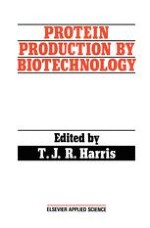1990 | OriginalPaper | Buchkapitel
Towards the Structure of Mosaic Proteins: Use of Protein Expression and NMR Techniques
verfasst von : Martin Baron, Alan J. Kingsman, Susan M. Kingsman, Iain D. Campbell
Erschienen in: Protein Production by Biotechnology
Verlag: Springer US
Enthalten in: Professional Book Archive
Aktivieren Sie unsere intelligente Suche, um passende Fachinhalte oder Patente zu finden.
Wählen Sie Textabschnitte aus um mit Künstlicher Intelligenz passenden Patente zu finden. powered by
Markieren Sie Textabschnitte, um KI-gestützt weitere passende Inhalte zu finden. powered by
Many extracellular proteins consist of numerous distinct but repeated domains. Figure 1 illustrates how relatively few domains, or modules, can be combined to make a wide variety of proteins associated with blood-clotting, fibrinolysis, complement and the extracellular matrix.1,2 The modules are often small disulphide bonded units of about 50 amino acids. They include: epidermal growth factor-like units (G); the ‘Kringle’ unit (K); fibronectin ‘fingers’ (F1, F2 and F3); the short consensus repeat seen in the C4 binding protein and other proteins of complement (C);3 a module which appears in thrombospondin and properdin (T);4 one seen in the LDL receptor (A)5 and modules with homology to the EF hands in calmodulin (E).6 There is a close relationship between these domains and the exon/intron structure of their genes. Exon duplication and shuffling was probably involved in the evolution of these mosaic proteins. It is significant that nearly all of these modules have phase 1 exon boundaries,7 such that exons may be duplicated, inserted or deleted without changing the reading frame for the rest of the protein. The modules have acquired diverse roles in their subsequent evolution. They appear to form autonomously folding structural units since disulphides are usually within rather than between modules. This is supported by the structures known so far.
